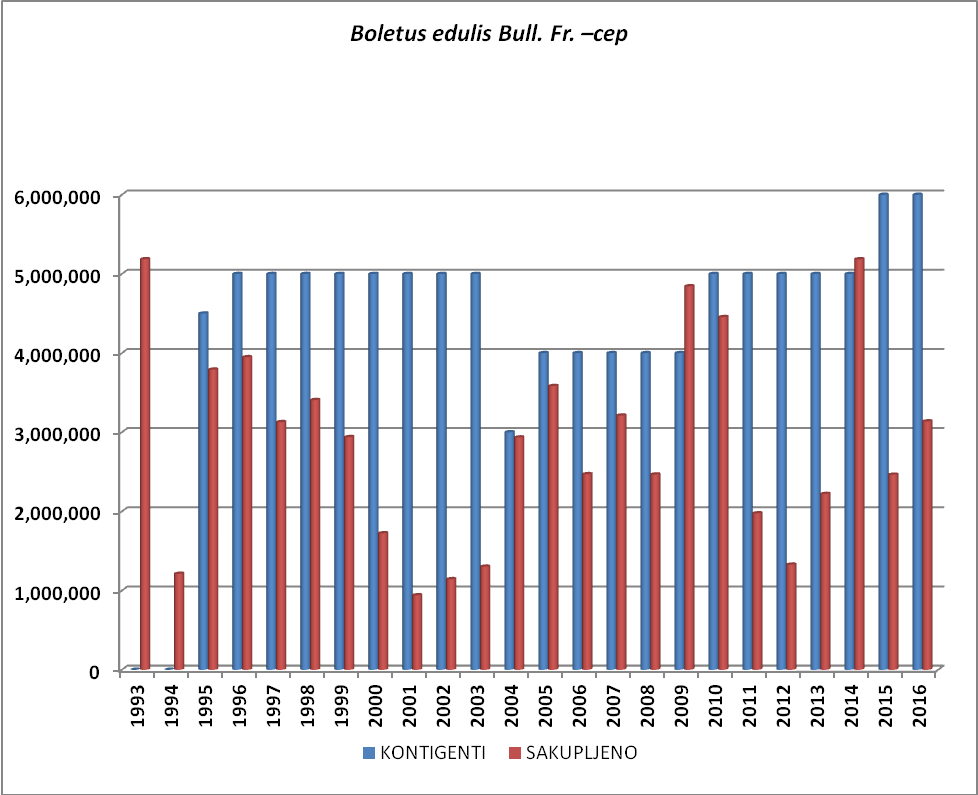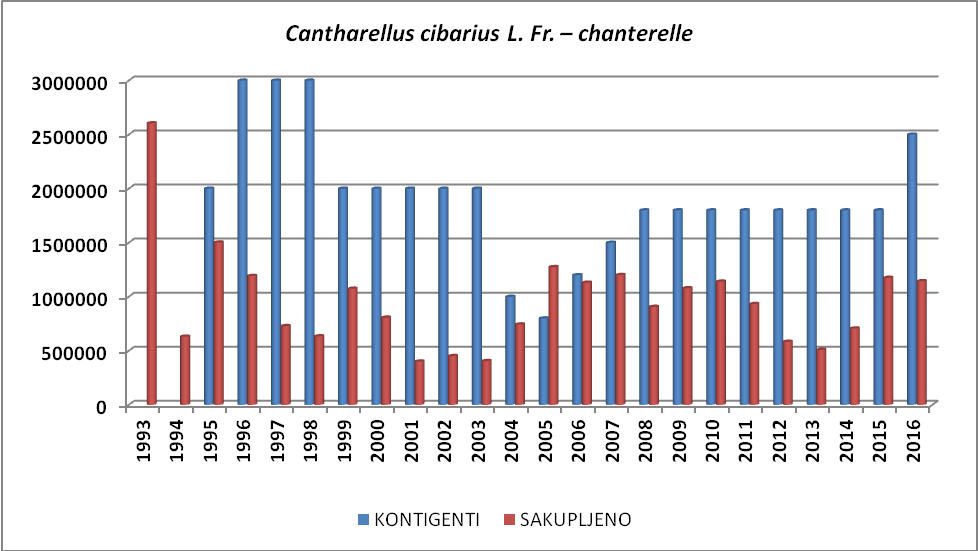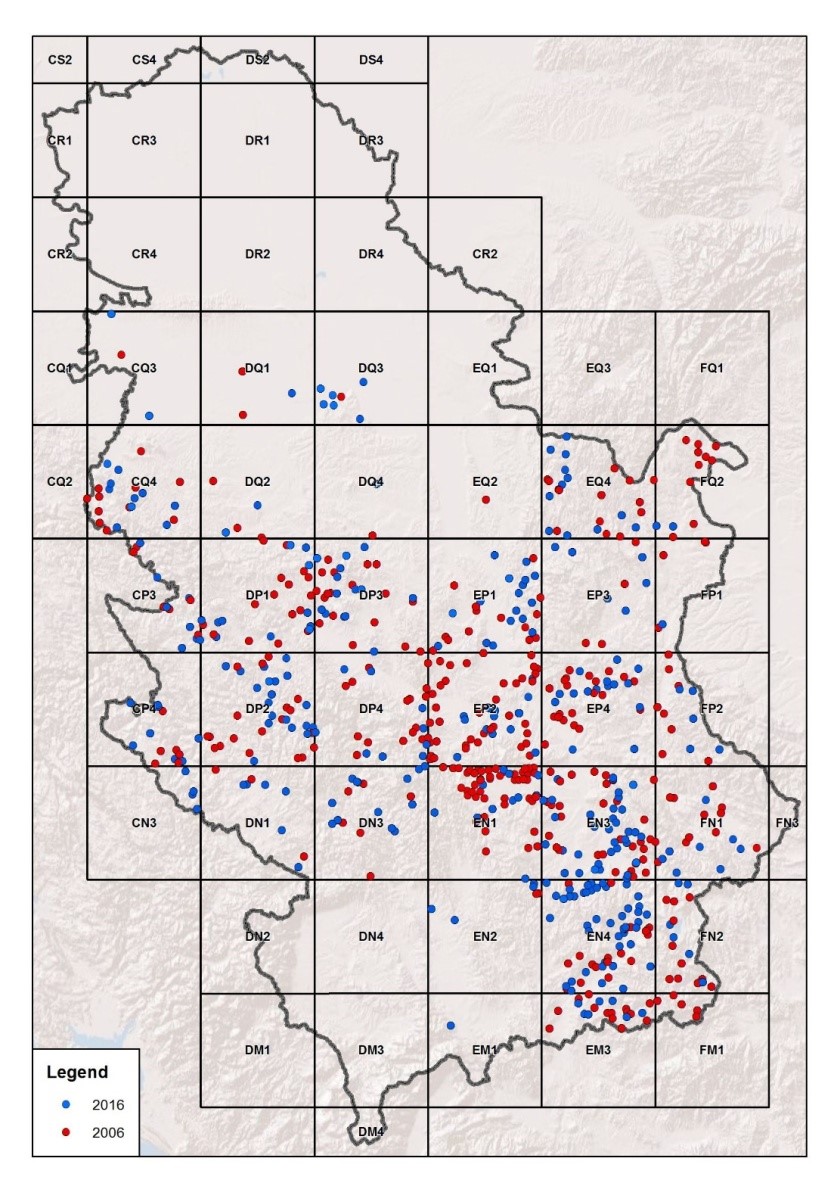The most harvested mushroom species is penny bun with the maximum collected amount of about 5,000,000 kg. The oscillations presented on the chart below are related to whether the year was dry or rainy, and not to the demand/supply ratio. The total amount of harvested penny bun during 24 years was 69,007,482 kg. The average amount of harvested penny bun in the observed period is 2,875,311 kg, which is the largest amount collected for any wild species harvested from nature. The maximum amount of 5,186,100 kg was collected in 1993. The total amount collected for the stated period was 22,968,407 kg, while the average amount collected was 957,016 kg. The collection of truffles in Serbia has been growing over the past twenty years, for the purpose of export mainly, many people are involved in collecting and trading also without permits and records of collectors and trained dogs. Certain quantities collected are illegally exported to the western market (Slovenia, Italy, France). One of the reasons is the calculated fee price paid to the state (for white truffles about 100 Euro per kilogram, and for the other two types of black truffles 11 and 15 Euro per kilogram). Consequently, increased controls of customs authorities, police and environmental inspections are needed.


Subindicator Name: Collection of mushroom species – penny bun, golden chanterelle
Institution/Author: University Futura/dr Radomir Mandić, Environmental Protection Agency/Slaviša Popović
Use and interpretation:
The Indicator shows level of uses of mushroom species – penny bun, golden chanterelle
Key question(s) which indicator helps to answer
What is the level of exploitation of mushroom species in Serbia? Are these species used in sustainable way?
Use of indicator
This indicator serve to monitor quantities of collected mushroom species, with focus on penny bun and golden chanterelle
Scale of appropriate use
The most harvested mushroom species, is penny bun with the maximum collected amount of about 5 000 000 kg. The oscillations seen on the chart below are related to whether the year was dry or rainy, and not to the demand/supply ratio. The maximum amount of 5 186 100 kg was collected in 1993. The total amount collected for the stated period was 22 968 407 kg, while the average amount collected was 957 016 kg.
Potential for aggregation:
Meaning of upward or downward trends („good or bad“)
The total amount of harvested penny bun during 24 years was 69 007 482 kg. The average amount of harvested penny bun in the observed period is 2 875 311 kg, which is the largest amount collected for any wild species harvested from nature. Weather conditions by years (bad year for mushrooms due to the great dry season) affect the quantity and quality of collected mushrooms.
Possible reasons for upward or downward trends:
Since 1993, in Serbia, the collection and placing on the market of mushrooms has been legally regulated, by the Order on putting control of the use and trade of wild plant and animal species (Official Gazette of RS, Nos. 50/93 and 36/94). Today, permits for the collection and trade of mushrooms are issued on the basis of the Decree on the Control of the Use and Trade of Wild Flora and Fauna (Official Gazette of RS, Nos. 31/05, 45/05, 22/07, 38/08, 9/09 and 69/11), and the licenses are issued by the Ministry of Environmental Protection, based on the opinion of the Institute for Nature Protection of Serbia.
Implications for biodiversity management of change in the indicator:
The collection of truffles in Serbia has been growing over the past twenty years, for the purpose of export mainly, many people are engaged in collecting and trading also without permits and records of collectors and trained dogs. Certain quantities collected are illegally exported to the Western market (Slovenia, Italy, France). One of the reasons is the calculated fee price paid to the state (for white truffles about 100 Euro per kilogram, and for the other two types of black truffles 11 and 15 Euro per kilogram). Consequently, increased controls of customs authorities, police and environmental inspections are needed.
Units in which it is expressed:
kg per year, number of samples per year
Description of source data:
Ministry of Environmental Protection, Institute for Nature Conservation
Calculation procedure:
Processing the data collected during 24 years, according to the regulations from 1993-2016.
Most effective forms of presentation:
(graph types, maps, narratives,etc.-give examples where possible):
The best ways to present this indicator are graphs and tables.
Limits to userfelness and accuracy:
Access to data for analysis
Updating the indicator:
Annually
Closely related indicators
Export of wild flora and fauna
Additional information and comments
